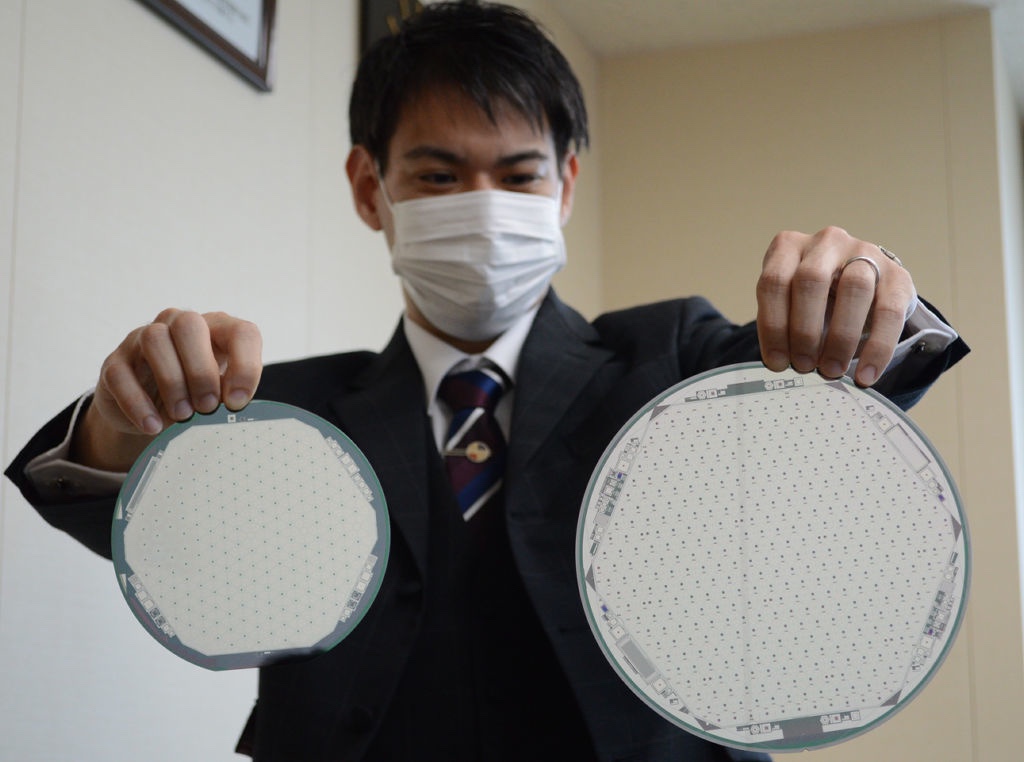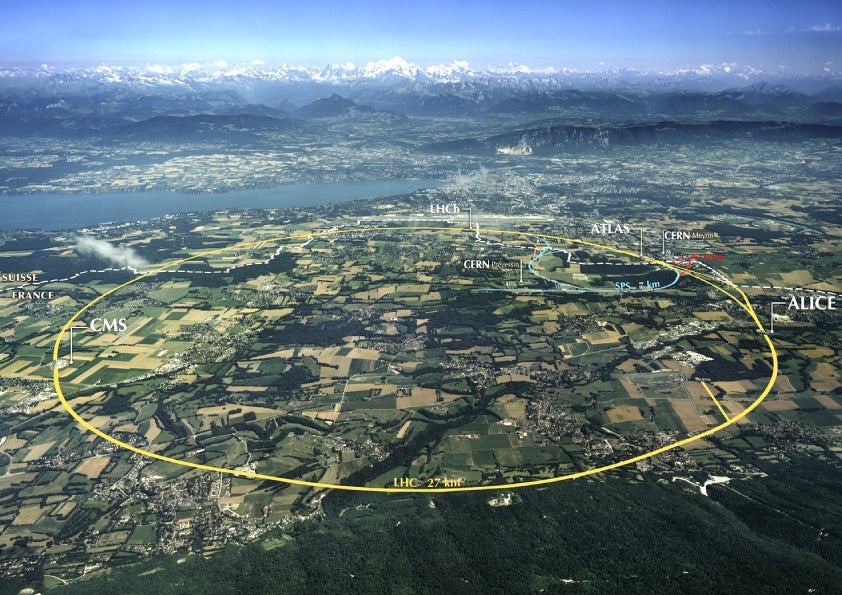

Approximately 100m underground in the suburbs of Geneva, Switzerland, there is an accelerator for the LHC project with a circumference of 27km.We plan to upgrade this accelerator and conduct HL-LHC experiments.
Hamamatsu Photonics: Providing new products to European CERN!
-Start of full-scale supply for HL-LHC experiments-
– Contribution to the precise measurement of the Higgs boson, a study to explore the mysteries of the universe –
Hamamatsu Photonics:
-Development of the world’s largest 8-inch pixel array detector-
On February 14, it was announced that full-scale supply to the European Joint Institute for Nuclear Research (CERN) would begin on the 27th.
To improve the performance of the Large Hadron Collider (LHC) in Switzerland,
The mass production system for the world’s largest photodiode (PD) array has been established.
Mass production of photodiode (PD) arrays:
A new product with a large area and high radiation resistance will contribute to experiments that approach the mysteries of the universe.
The 6-inch size that has already been prototyped has been expanded to 8 inches so that it can withstand harsh radiation environments.
Although it is only 0.3mm thick, it has the ability to operate at a high voltage of 800 volts.
Role of PD array:
– Precise measurement of the “Higgs boson” that gives weight to all things –
It plays the role of measuring the energy and trajectory of the radiation that protons collide with and scatter.
A new HL (High Luminance) LHC that greatly enhances the search sensitivity for new unknown particles
An optical semiconductor element PD array is provided in the detector.
Operation after 2026:
The contract amount is approximately 1.7 billion yen.
It will be produced at the Ichino head office factory for operation after 2026.
The company plans to deliver 27,000 units by the summer of 2025.
Hamamatsu Photonics:
Provided optical semiconductor devices and photomultiplier tubes to the LHC.
In addition to the newly developed PD array, 50,000 sensors will also be supplied to the HL-LHC.
Your Shizuoka Newspaper
https://www.at-s.com/news/article/shizuoka/1193865.html
Hamamatsu Photonics : fournir de nouveaux produits au CERN européen !
-Début de l’approvisionnement à grande échelle pour les expériences HL-LHC-
– Contribution à la mesure précise du boson de Higgs, une recherche qui aborde les mystères de l’univers –
Photonique Hamamatsu :
-Développement du plus grand détecteur à matrice de pixels de 8 pouces au monde-
Le 14 février, il a été annoncé que l’approvisionnement à grande échelle de l’Institut commun européen pour la recherche nucléaire (CERN) commencerait le 27.
Pour améliorer les performances du Large Hadron Collider (LHC) en Suisse,
Le système de production de masse du plus grand réseau de photodiodes (PD) au monde a été mis en place.
Production en série de matrices de photodiodes (PD) :
Un nouveau produit avec une grande surface et une haute résistance aux radiations contribuera à des expériences qui approchent les mystères de l’univers.
La taille de 6 pouces qui a déjà été prototypée a été étendue à 8 pouces afin qu’elle puisse résister aux environnements de rayonnement difficiles.
Bien qu’il ne fasse que 0,3 mm d’épaisseur, il a la capacité de fonctionner à une haute tension de 800 volts.
Rôle du tableau PD :
– Mesure précise du « boson de Higgs » qui donne du poids à toute chose –
Il joue le rôle de mesurer l’énergie et la trajectoire du rayonnement avec lequel les protons entrent en collision et se dispersent.
Un nouveau LHC HL (High Luminance) qui améliore considérablement la sensibilité de recherche de nouvelles particules inconnues
Un réseau PD d’éléments semi-conducteurs optiques est prévu dans le détecteur.
Exploitation après 2026 :
Le montant du contrat est d’environ 1,7 milliard de yens.
Il sera produit à l’usine du siège social d’Ichino pour fonctionner après 2026.
L’entreprise prévoit de livrer 27 000 unités d’ici l’été 2025.
Photonique Hamamatsu :
Fourniture de dispositifs semi-conducteurs optiques et de tubes photomultiplicateurs au LHC.
En plus du réseau PD nouvellement développé, 50 000 capteurs seront également fournis au HL-LHC.
Votre journal de Shizuoka
Hamamatsu Photonics: Bereitstellung neuer Produkte für das europäische CERN!
-Beginn der Vollversorgung für HL-LHC-Experimente-
– Beitrag zur präzisen Messung des Higgs-Bosons, einer Forschung, die sich den Mysterien des Universums nähert –
Hamamatsu-Photonik:
-Entwicklung des weltweit größten 8-Zoll-Pixel-Array-Detektors-
Am 14. Februar wurde bekannt gegeben, dass die vollständige Lieferung an das Gemeinsame Europäische Institut für Kernforschung (CERN) am 27. Februar beginnen würde.
Um die Leistung des Large Hadron Collider (LHC) in der Schweiz zu verbessern,
Das Massenproduktionssystem für das weltweit größte Photodioden (PD)-Array wurde etabliert.
Massenproduktion von Photodioden(PD)-Arrays:
Ein neues Produkt mit großer Fläche und hoher Strahlungsresistenz wird zu Experimenten beitragen, die sich den Geheimnissen des Universums nähern.
Die bereits prototypisierte 6-Zoll-Größe wurde auf 8 Zoll erweitert, um rauen Strahlungsumgebungen standzuhalten.
Obwohl es nur 0,3 mm dick ist, kann es mit einer Hochspannung von 800 Volt betrieben werden.
Rolle des PD-Arrays:
– Präzise Messung des “Higgs-Bosons”, das allen Dingen Gewicht verleiht –
Es spielt die Rolle, die Energie und Flugbahn der Strahlung zu messen, mit der Protonen kollidieren und gestreut werden.
Ein neuer HL (High Luminance) LHC, der die Suchempfindlichkeit für neue unbekannte Teilchen erheblich verbessert
In dem Detektor ist ein optisches Halbleiterelement-PD-Array vorgesehen.
Betrieb nach 2026:
Die Vertragssumme beträgt ca. 1,7 Milliarden Yen.
Es wird im Werk der Ichino-Zentrale für den Betrieb nach 2026 produziert.
Bis Sommer 2025 will das Unternehmen 27.000 Einheiten ausliefern.
Hamamatsu-Photonik:
Bereitstellung von optischen Halbleiterbauelementen und Photomultiplierröhren für den LHC.
Neben dem neu entwickelten PD-Array werden auch 50.000 Sensoren an den HL-LHC geliefert.
Ihre Shizuoka-Zeitung